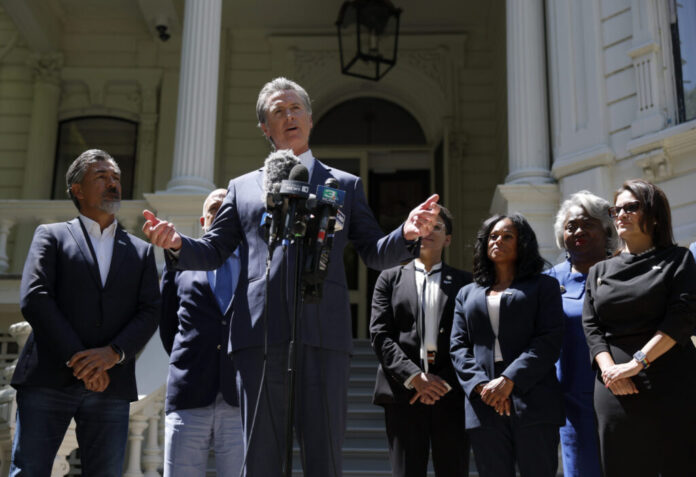California Democratic Gov. Gavin Newsom speaks during a news conference with Texas lawmakers at the Governor’s Mansion on July 25, 2025 in Sacramento. California Newsom met with Texas lawmakers to push back on Texas’s redistricting maneuver that aims to tilt the outcome of the 2026 midterm elections and on how California plans to respond. (Photo by Justin Sullivan/Getty Images)
How much could an unusual mid-decade redistricting push matter for control of Congress next year?
Experts are split, but generally see little advantage in the frantic activity by both parties to squeeze extra seats from lines that already favor Republicans in Texas and Florida and Democrats in California.
Texas Republicans proposed a new set of maps Wednesday, in response to a request from President Donald Trump to boost GOP numbers in the U.S. House of Representatives by redrawing the lines to favor Republicans. Left-leaning California, meanwhile, has pledged to retaliate by redrawing its congressional districts to create more Democratic seats.
The unusual plan to draw new districts in mid-decade for political purposes is not unprecedented — Republicans in Colorado and Texas moved to redraw districts after taking unified control of those states in 2002. But generally, states draw new districts only when federal law requires it after a new decennial census.
Trump reportedly asked Texas Republicans to target five Democratic incumbents to shore up their thin U.S. House majority against anticipated losses in midterm elections next year. He also pressured Missouri Republicans to redraw a Democratic Kansas City-area district. Florida Republican Gov. Ron DeSantis has said he would follow suit.
California has threatened a retaliatory plan to increase Democratic seats there and a Democratic super PAC has created a $20 million fund to target Texas Republicans next year as payback.
It’s not impossible for Texas to come up with five more Republican seats that would withstand legal challenge, said J. Miles Coleman, political cartographer at the Center for Politics at the University of Virginia. But Coleman said it would take some “creative line drawing.”
Paul Brace, an emeritus professor of legal studies science at Rice University in Houston, said the proposed Texas maps released today target Democrats in majority-minority districts in Houston, the Dallas-Fort Worth area, and South Texas, where Trump showed surprising strength in last year’s election.
“They’re trying to dilute those areas with more white Republican areas to give themselves a better chance,” said Brace. He said he’s skeptical Texas Republicans can draw five more GOP seats that will withstand legal scrutiny, though they might be able to get one by redrawing the Houston-area district that has been unrepresented since Democratic U.S. Rep. Sylvester Turner died in March.
Other changes are not as clear-cut, he said.
Kimball Brace, a redistricting expert and consultant in Virginia who is not related to Paul Brace, said Texas might have already reached its maximum number of GOP seats.
“The question about Texas is, are they already maxed out for Republican strength? There’s not much wiggle room left,” he said.
Kimball Brace said there may be some benefit to Republicans in redrawing South Texas districts, where Republican strength was greater than expected last year, but there’s nothing like five seats in play. He said he thinks California is in a similar situation, since for decades, California Democrats have drawn maps to maximize their advantage and might not have much more room to maneuver.
Coleman disagreed, saying he sees opportunities in both states for new seats.
“For the purposes of keeping score, Texas and California could basically cancel each other out. But I think Democrats would be hurt if the redistricting wars escalate beyond those states,” Coleman said.
Florida and Missouri could add more Republican seats, and theoretically Colorado, New York and Virginia could add more Democratic seats, but the Democratic states will run into self-imposed obstacles like redistricting commissions that limit partisan maneuvers, Coleman said. Republican-dominated Ohio will also be a factor, since it’s planning to redraw districts because of court fights.
“That will almost certainly be to the benefit of Republicans, so it’s another example of Republicans having more levers to pull than Democrats,” Coleman said. .
Earlier this week, New York unveiled its own mid-decade redistricting plan, but it wouldn’t take effect in time for next year’s midterm elections.
Kimball Brace said Michigan, where he has worked as a consultant, could add more Democratic seats in theory, but a fragile compromise on a politically independent redistricting commission makes it unlikely.
Parties in power generally draw districts that favor their own with methods known as “packing” and “cracking.” “Packing” refers to concentrating opposition party voters in a small number of districts to reduce competition elsewhere. “Cracking” means scattering opposition voters across districts, so they have little chance to influence votes.
Texas and Florida already have wrung more partisan advantage from their congressional seats than any other states, by one measure.
PlanScore, a project at Harvard Law School’s Election Law Clinic that measures bias in redistricting, found at least some partisan bias in congressional districts in many states where data on voter registration was available.
About two of California’s 52 U.S. House seats are Democratic but would be Republican under a perfectly balanced plan based on statewide party registration. Texas already squeezes about five extra Republican seats out of its 32 U.S. House districts, one of the most skewed maps in the country. Florida has an extra four GOP seats, out of 28 total.
Stateline reporter Tim Henderson can be reached at thenderson@stateline.org.
This article was first published by Stateline, part of States Newsroom, a nonprofit news network supported by grants and a coalition of donors as a 501c(3) public charity. Stateline maintains editorial independence. Contact Editor Scott S. Greenberger for questions: info@stateline.org.



